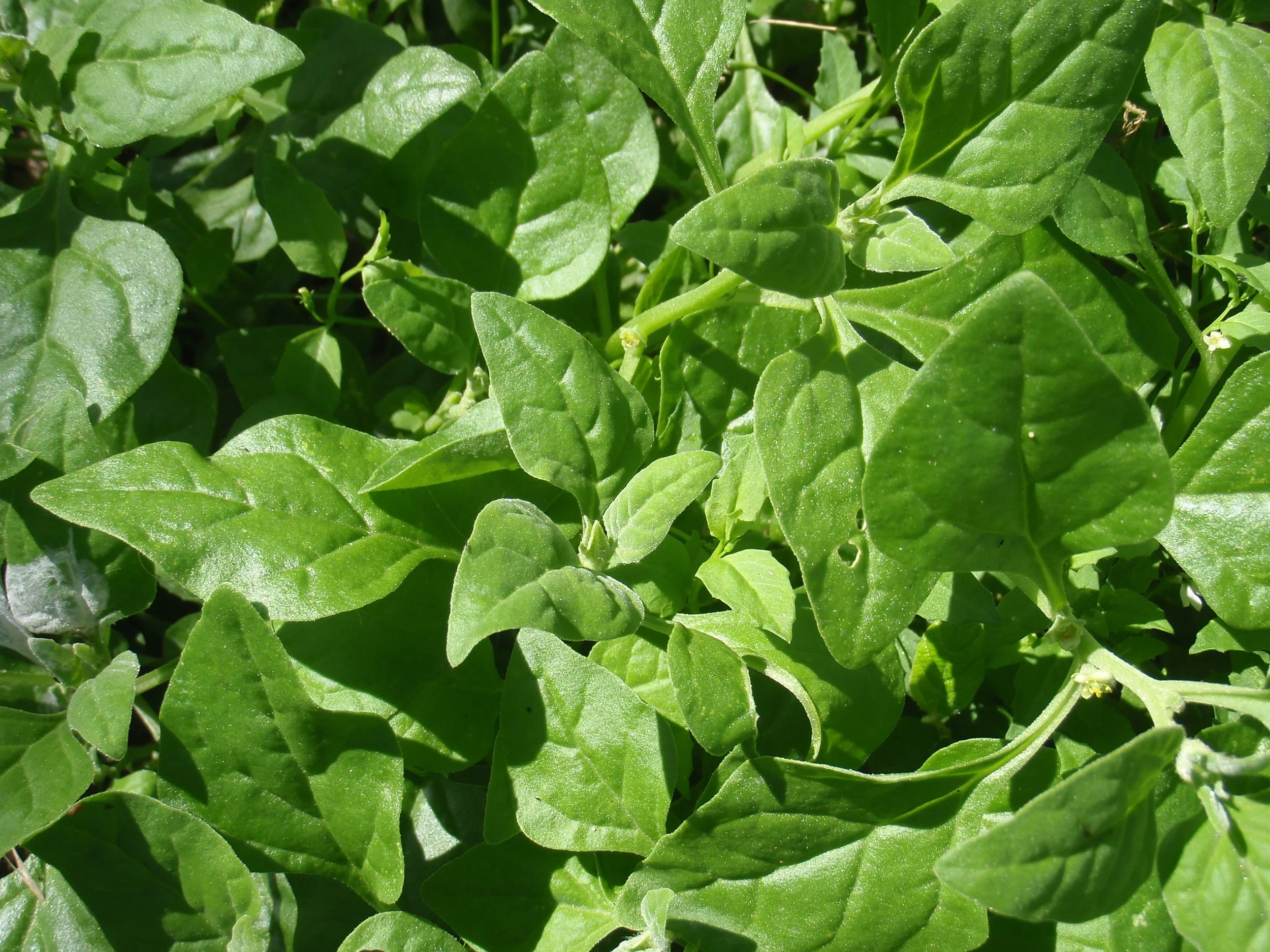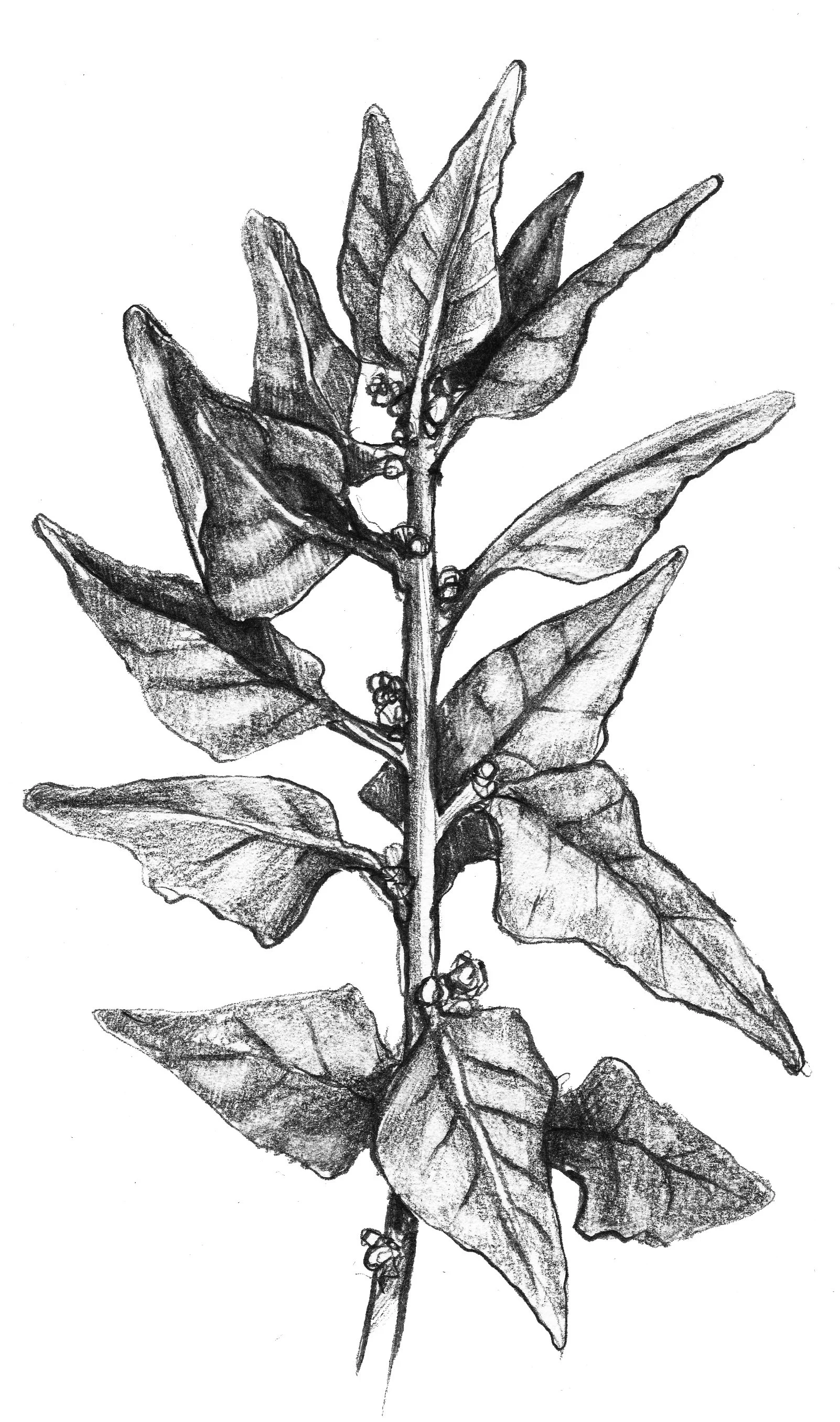Native spinach- Forage, cook, eat.
Native spinach
Tetragonia spp.
Native spinach (aka warrigal greens, New Zealand spinach, Botany Bay spinach and bower spinach) has become one of Australia’s most celebrated edible indigenous greens.
In our house, we love it as a pie filler, pizza topper and use it in similar ways as we would baby spinach.
As a wild foraged ingredient, native spinach is very easy to recognise, and it can cope with, or even benefit from, low-level tip pruning. By harvesting 10 centimetres off the tips of the branches that you will find growing along the ground, you are promoting new growth. Today, native spinach is cultivated as a vegetable, and is stocked by many local greengrocers.
There are two main varieties of native spinach: warrigals, Tetragonia tetragonioides, which grow from Queensland to Victoria, including inland; and Bower spinach (Tetragonia implexicoma), which is mostly coastal, found growing from eastern Victoria all the way to Western Australia. Both species are edible, and interchangeable for culinary purposes.
Here in Australia, native spinach owes its celebrity status to Captain Cook, who collected it on his voyage to the southern seas in 1770. The Endeavour’s botanist, Joseph Banks, took some seeds back to Kew Gardens in England, and in the 19th century native spinach for a time became popular in the UK and Europe as a novelty vegetable. It is now all but forgotten there, except in a few areas of France and Brazil, where it is still extensively cultivated. Today, however it is making a comeback in the kitchens of hipster chefs across urban Australia.
For Australia’s early European colonists, native spinach became a much-celebrated food, used as a spinach substitute to alleviate the onset of scurvy in a time and place where traditional European green vegetables were scarce. By contrast, Aboriginal peoples seldom used it, as the plant’s nutritional qualities are negligible.
Drawing by Mirra Whale
Identification
Native spinach is a perennial herb, with creeping stems that spread along the ground and branch out at nodes. The plant continues to expand year after year, forming large areas of leafy, exclusive growth up to several metres wide.
Leaves and stalks
The diamond-shaped leaves have visible veins on their undersurface, and are covered with crystal-like drops sweating from the leaves; they look as if they have been sprayed with water.
The main visual differences between the two forms of native spinach relate to the leaves and the branches. Bower spinach has smaller leaves than warrigals, reaching only 3–5 centimetres long, but its branches are longer, growing up to 3 metres in length. Warrigal leaves can grow up to 15 centimetres, but the plant’s branches only spread to a width of 1 metre.
Flowers and fruits
The flowers are yellow, and are hidden at the intersection between the branches and the leaves’ stems. Warrigals produce pyramid-shaped fruits, 3–6 millimetres across; at first green, they mature to light brown to black, and are very tough. The fruits of Bower spinach are 5–8 millimetres in diameter, round and berry-like; they mature to become light red and juicy.
Distribution
Native spinach can be found in all states but Northern Territory, quite commons in coastal areas and along estuaries of rivers. Inland can be found along creeks, at the edge of swamps and dams and generally in wetter areas. It can withstand some dehydration but would not thrive or survive for long. It can tolerate poor sandy soil and high salinity.
As food
Native spinach is found on modern Australian menus as a topping on hipster pizzas, as a dumpling filling and as a boiled side green. The leaves are the only part of the plant eaten; they are harvested when young, as older leaves develop a pungent, acrid flavour.
In our house we mostly use this green as a replacement for common baby spinach. We blanch the leaves, and then mix them with other veggies and creamy sauces as a filler in pies and savoury vegetarian pastries.
Oxalic Acid: Why Blanching is Essential
One important thing to know about warrigal greens is that, like many leafy greens (including spinach, silverbeet, and rhubarb leaves), they contain oxalic acid (oxalates). Oxalates can interfere with the body’s ability to absorb calcium and, in large amounts, may contribute to kidney stone formation or irritation in the mouth and throat. While the levels in warrigal greens are not dangerous if prepared properly, it is strongly recommended not to eat them raw in large quantities.
To reduce oxalate levels, blanch the leaves briefly in boiling water for one to two minutes, then drain and refresh in cold water. This simple step removes most of the oxalates, making the greens safe and enjoyable to eat. The blanching water should be discarded, not reused for cooking.
For people with a history of kidney stones or other conditions requiring a low-oxalate diet, warrigal greens should be eaten in moderation and always prepared correctly.
Warrigal flatbread
This is a perfect pairing with Weedy pesto. Recipe curtesy ofd Marnee Fox of Forage to Feast.
Makes 8 flatbreads
Ingredients
1½ cups steamed warrigal greens cooled
3 garlic cloves
1½ teaspoons sea salt
2 tablespoons extra virgin olive oil
1/4 cup Greek style yoghurt
1/3 cup sparkling water
2 cups wholemeal, plain or spelt flour
Extra flour for dusting
Method
1. Place the cooled warrigal greens, garlic, salt, olive oil, yoghurt and sparkling water in a blender. Process until smooth.
2. Place the flour in a medium-sized bowl and make a well in the centre. Add the warrigal paste. Using a wooden spoon, mix the paste into the flour to form a rough dough.
3. Dust a clean working surface with flour. Place the dough on the flour and knead it until smooth, then divide the dough into eight equal portions. Using your hands, form each portion into a round shape, flatten it with the palm of your hand and dust both sides with flour.
4. Use a rolling pin to roll each portion into a 15 cm round.
5. Heat a frying pan over medium heat. Fry the flatbreads for approximately 2–3 minutes on each side, until cooked and golden.
6. Place the cooked warrigal flatbreads in a tea towel and fold the edges over to cover and keep them warm.
7. Slice the flatbreads into wedges and serve with fresh pesto.
Further research
Wikipedia on native spinach
Atlas of Living Australia on native spinach
U.S. Department of Agriculture Nutritional analysis of native spinach
Tucker Bush on native spinach






